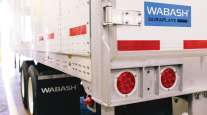Senior Reporter
Wabash Pursues Growth Strategy Beyond Dry Vans

Wabash National Corp. announced it will expand its use of advanced materials and grow its diversified and final-mile segments to counter the expected industry slowdown in demand for dry vans.

Yeagy
“There is a technology revolution occurring in advanced materials. It is undeniable,” Wabash CEO Brent Yeagy said during its Analysts Day call in February. Fleets are increasingly accepting of the new, premium materials, he said.
“We have products coming to bear,” he said. “We need to enlarge that and take full advantage of that. We know what it means to innovate, disrupt the markets through the use of technology. We are expanding that. Call it going back to our roots. That’s what we are looking at as we grow going forward.”
Wabash expanded the space devoted to manufacturing molded structural composites to 225,000 square feet in 2018, up from 100,000 square feet in 2017. The workforce working on MSC increased last year to 100 compared with 80 a year earlier. Research and development expenses rose to $5.6 million, up 43% compared with $3.9 million in 2017.
It has five related patents, 10 patent applications, 10 trade secrets and four suppliers to bolster its efforts in this area.
Its composites include DuraPlate, cell core, glass reinforced plastic laminates and honeycomb panels that are lighter weight, corrosion resistant and have improved durability.
Wabash launched its initial composite panel technology, DuraPlate, in 1996. It is has a high-density polyethylene core, thermally bonded between two high-strength steel skins.
It's official—we delivered our 100th Cold Chain refrigerated truck body with our MSC technology to Wabash dealer @StoopsTrucks. Our MSC technology improves thermal efficiency by up to 25% over conventional designs, while reducing weight by up to 15%. https://t.co/WEgd1oemup pic.twitter.com/dizPphVVyW — Wabash National (@WabashNational) January 28, 2019
The nature of inventory is changing; the number of times freight is touched is going up; and the number of times it gets redistributed is going up, Yeagy said.
Meanwhile, Forrester Research projected e-commerce sales to increase at an 8% to 12% compound annual growth rate over the next few years. Grocery and home delivery will ensure growth continues both for truck bodies, and upfit and inserts, according to Wabash.
At the same time, Wabash expects to grow its diversified products business, including tank trailers used to carry crude or refined products, as well as others hauling milk.
U.S. milk production in 2017 totaled 215.5 billion pounds, an increase of 3.1 billion pounds compared with 2016. The 2017 total is a record high for the eighth consecutive year, according to data the Central Milk Marketing Order provided.
Average U.S. oil production is forecast to grow by about 20% by 2020 compared with 2018 volumes.
RELATED: Wabash Reports Mixed First-Quarter, Full-Year Earnings
U.S. crude oil production is forecast to average 12.4 million barrels a day in 2019 and increase to 13.2 million barrels a day in 2020, with most of the growth coming from the Permian region of Texas and New Mexico, according to the Energy Information Administration.
The average production was about 11 million barrels a day in 2018, and in 2017 was about 9 million barrels a day.
Wabash has been the No. 1 or No. 2 ranked trailer maker of dry vans for 25 of the last 30 years. The total dry van market in 2018 was $4.5 billion, according to Wabash, which owned $1.2 billion of that and forecasts its share to grow “somewhat” by 2021 amid what is widely seen as a slowing market. Some analysts predict the market could slow as soon as the second half of this year.
Overall, Wabash said that it is taking aim at revenue of $2.2 billion — with about half coming from lines other than commercial trailer products — an operating margin of 8% and earnings per share of $1.90 to $2.10 by the end of 2021.
One analyst called these “ambitious targets.”
“The centerpiece of the company’s analyst day was its target of an 8% operating margin by 2021,” Stifel Nicolaus & Co. analyst Michael Baudendistel wrote in a note to investors. “It strikes us that there is a significant negative mix given that the CTP segment, the highest margin segment, is expected to decline while the other two segments, with much thinner margins, are expected to show revenue growth.”


